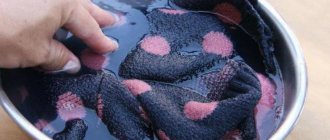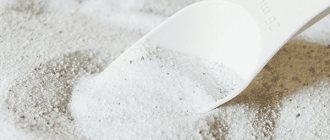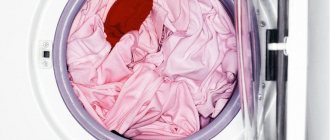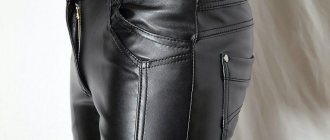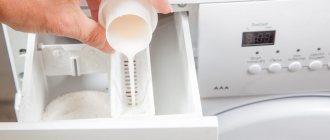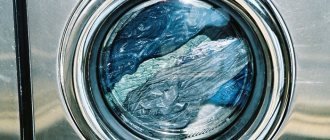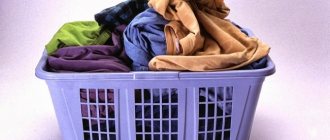How to turn off the heating in the machine?
The programs stored in the memory of the automatic machine involve heating water to a certain temperature. Typically, washing machines have modes of 30°C, 40°C, 60°C, 95°C. All models of washing machines from different manufacturers allow the ability to completely turn off the heating in order to wash in cold water.
So, on LG washing machines, in order to start washing without the participation of a heating element, you need to press the “Temperature” button on the control panel until the indicator lights up opposite the inscription “Cold”. In this case, the heating element will not be activated; the machine will use tap water at the original temperature.
Indesit washing machines have a special temperature switch. If you turn the knob to the “Snowflake” icon and start the wash, the water drawn into the system will not heat up. Bosch washing machines are equipped with a button with the “°C” symbol. You should click on it several times until the indicator opposite the snowflake symbol lights up. Candy machines have a separate button on the panel, by clicking on which you can turn off water heating in any mode.
The instructions for a specific washing machine model describe how to wash in cold water.
If the user manual has been lost for a long time, the necessary information can be found on the Internet. To do this, you should create a search query with the full name of the machine, for example, “Samsung WF8590NLW8DYLP instructions.” This is how you will find the “booklet” for the machine in electronic form.
How to prepare clothes for washing
Inspect each item carefully. If you find stains, treat them before washing. Soak the item in water and remove the stain with powder or laundry soap. Particularly difficult stains can be treated with a stain remover.
Check your pockets - they should be empty. Fasten all buttons, zippers and snaps. This way the item will not be deformed, and hooks and fasteners will not tear other clothes during washing.
It is better to turn jeans, clothes with embroidery, prints and other decorative elements inside out. Delicate items with lace and rhinestones, as well as bras with underwire, are best placed in a special laundry bag. It will protect clothes from damage, and the machine from possible small parts getting into the mechanism.
The benefits of cold washing
How does washing in cold water benefit the user? First of all, the energy consumption per cycle is significantly reduced. Heating “eats up” enough kilowatts, and in this case the heating element simply will not work. Don't worry that this cleaning will be ineffective. Modern, high-quality detergents quickly dissolve even in cool water, and wash away dirt without any problems.
There is a misconception that when doing a “cold” wash, you need to put more detergent into the machine. In fact, there is no need to use extra powder, the standard dosage is enough.
However, in some cases it may be necessary to wash in hot water. For example, if necessary:
- carry out antibacterial treatment of things, disinfect fabric;
- remove old, difficult to remove stains;
- wash towels and bed linen.
Thus, a “hot” wash will be useful when processing items that collect more bacteria than everyday clothing. We are talking about towels, which from time to time it is useful to even turn them on the “Boiling” mode. It is better to wash T-shirts, dresses, shirts, skirts, blouses in cold water or at a heating temperature of 30°C. This will prevent the products from deforming, shrinking, and fading.
Bonus
A significant “advantage” of hot washing is the “increase” of kilowatts. Its frequent use in everyday life greatly increases the consumption of electricity, which hurts the wallet.
If you reconsider your habits, which are hardly justified, then payment receipts will no longer be so frightening with their total amounts.
Important! When you turn on the washing machine, most of the electricity is consumed to heat the water. And this is a lot - 90% of the total.
Cold mode eliminates all these problems. So you should only use hot wash when absolutely necessary.
Subscribe to our Social networks
Housewives' arguments for cold water
Everyone knows that high-temperature washing destroys the fiber structure of fabrics. This applies most of all to wool and other delicate materials. If you load a woolen sweater into the drum and run the 60°C or 90°C mode, you can remove a blouse that has shrunk 2-3 sizes from the washing machine and has already become “childish.”
Other clothing may, on the contrary, stretch due to high-temperature exposure and lose its shape irrevocably. Also, sometimes hot water causes holes to appear on the seams of products, due to the thinning of the fabric fibers during such “heavy” processing for them. So, after a couple of washes, the item may no longer be repairable, and you will have to throw it away.
The main reasons for cold water. She:
- does not destroy fabric fibers, preserves their original structure;
- does not lead to fading of things, but, on the contrary, maintains the brightness of the shades. Hot water, on the contrary, washes away rich colors from the material;
- does not contribute to the appearance of white streaks on clothes, which often remain after high-temperature washing.
An additional advantage of “cold” washing is energy savings.
If you stop daily “refreshing” things at a temperature of 40°C or even 60°C, and instead run a “cold” wash, you may be pleasantly surprised when you receive receipts. The electricity bill will be much lower than usual.
It should also be noted that there is less wear on the sealing collar, which can deteriorate from “boiling water”. The heating element also does not need to work, so the service life of the heating element of the washing machine is extended. And, of course, the things themselves will retain their original shape longer.
Washing in cold modes gives housewives the opportunity to forget about damage and shrinkage of clothes, loss of brightness of fabrics, and stains remaining on things. You should resort to high-temperature programs only in extreme cases when it is really necessary. If you buy high-quality detergents, you won’t have any problems removing stains – cool water will also effectively remove stains.
Interesting:
- How to choose a brand of washing machine?
- Types and types of washing powders
- Which Bosch washing machine is better to buy?
- Rating of Samsung washing machines
- What is the water consumption of an automatic washing machine?
- Gorenje washing machine self-cleaning program
1 reader comment
- 06/29/2021 at 08:10
Tatiana:
What temperature should I choose for washing in hot water on a Kandy machine?
Answer
How to wash in plain water without powder when traveling
If you did not take detergents with you on your hike, you will have to wash your clothes simply in water without detergents.
How to wash clothes in clean water:
- for starters, avoid using light-colored clothing, wear dark-colored clothing if you are hiking;
- soak clothes in a bucket of hot water before washing for at least 15 minutes - the hotter the water, the better;
- stand inside the bucket and march in place. at least two minutes, as a bonus you will receive a warm foot bath;
- Now all that remains is to squeeze it out well and let the clothes dry in the sun.
Clothes may not be 100 percent clean after washing, but they are clean enough and, of course, odorless. A little clean is better than nothing.
So we answered the question whether it is possible to wash clothes simply with clean water without detergent.
Wash polyester with size reduction
At what temperature should I wash a T-shirt that has an artificial composition? It is quite easy to shrink synthetics; to do this you need:
- Set the washing machine to the permissible temperature and select the medium spin mode. This is enough to carry out the procedure.
- If you don’t have a washing machine, a container of water with a temperature of no more than 30 degrees will come to the rescue. In order for the item to shrink after washing, it must be kept under these conditions for about 15 minutes.
Well-wrung out wardrobe items are hung on hot radiators or hung out in the fresh air directly in the sun. After complete drying, products made from artificial fibers take on the required dimensions.
When to use hot water when washing?
- Benefits: removes serious stains such as oil stains, treats laundry from bacteria, fungi, and dead insects.
- Suitable for: white cotton items, including underwear, that have direct contact with the body; bed linen; kitchen textiles stained with grease.
EN-Waeschepflege-Icons
Problems: can contribute to fading, leaving protein stains, shrinkage of things.
General recommendations
There are several ways to reduce the size of wardrobe items made from different types of fibers. To do this, it is not at all necessary to use expensive special equipment and use the services of an atelier or dry cleaner. It is enough to know how to wash so that the item shrinks; usually, contrasting water temperatures are used for this. In addition, some household items can reduce clothing size. How to shrink items when washing without harming the fibers? The following will help guide you through the process:
- The quality of the fabric and its composition can be determined by examining the manufacturer’s tag.
- Availability of cold and hot water.
- Washing machine.
- Detergent for washing white and colored items.
- High quality iron.
- Container for soaking wardrobe items.
- Clean towels.
It is necessary to put the product in order in its pure form; if there are traces of dirt or stains on the item being processed, then these defects are immediately removed, and only then they begin to restore the appearance.
Linen
How to wash
Undyed linen can be washed at temperatures up to 90°C, while colored items are suitable for cooler water – 30–40°C. Such things can withstand spinning at 600 rpm, but you shouldn’t twist them by hand: you can overdo it and stretch or tear the fabric.
Chlorine bleaches are not suitable for linen. If you need to remove a stubborn stain, use oxygen products. Soak your clothes with them before washing and set the extra rinse mode.
If there is embroidery on a linen item, it is better not to take risks and wash such a product by hand so that it does not fade. You cannot soak the area with the pattern for a long time and vigorously rub it, as you will only ruin the clothes.
All about water
October 2021
| Mon | W | Wed | Thu | Fri | Sat | Sun |
| " March | ||||||
| 1 | 2 | 3 | ||||
| 4 | 5 | 6 | 7 | 8 | 9 | 10 |
| 11 | 12 | 13 | 14 | 15 | 16 | 17 |
| 18 | 19 | 20 | 21 | 22 | 23 | 24 |
| 25 | 26 | 27 | 28 | 29 | 30 | 31 |
Use of folk remedies
Who among us doesn’t remember grandma’s snow-white, starched pillowcases and clean, frost-smelling bed linen?
But they did all this with their hands, using folk remedies, tricks, and secrets. For those who prefer to do without chemicals in household chores, we can remind you of some folk recipes:
- Ash is perhaps the most ancient substance for this. It was added to water in a canvas bag, white linen was placed there, and it was boiled in a special tub on the stove. Then they were rinsed and hung out in the cold or laid out in the snow. Nature made things snow-white.
- After the advent of laundry soap, it was indispensable for hand washing for a long time; its solution was used in activator-type machines before the advent of powders and later. This soap removes dirt well due to its high alkali content.
- Mustard has long been used for silk and woolen items; it works less well with cotton. First, prepare a solution of 20–25 grams of dry mustard powder and 1 liter of warm (not higher than 400) water. After three hours, the liquid is carefully drained, it can be washed, it foams well and cleans.
- Bean decoction - 200 g per 1 liter of water, boil the beans, beat the decoction until foamy, use for soaking and washing.
- Soap root of the saponaria plant. It will take time to prepare a soap solution from it. It is split into fibers, brewed with boiling water, left for a day, the liquid is drained, boiled again, and filtered. After this it is ready for use. The resulting composition cannot be stored; it quickly deteriorates.
- Potatoes, soap nuts, horse chestnut powder, and regular table salt are also used.
- Instead of conditioner, use salt or ammonia, the laundry will be softer.
- To wash heavily soiled, for example, work clothes, borax and trisodium are added to the solution. There are ways to use sunflower stems (their ash), sunflower oil, and hydrogen peroxide. These folk recipes, without unnecessary chemicals, will help maintain the health of family members and protect nature from the influence of phosphates and other harmful components of synthetic detergents.
Benefits of hand washing
Having learned how to properly wash things by hand, many begin to find undoubted advantages in this method. In a washing machine, for example, until the end of the cycle it is impossible to control:
- Is there enough detergent;
- Is the laundry rinsed well?
- Has the stain come off?
For some, this is already an outdated method. In an age of universal employment and an acute lack of free time, an automatic car is a panacea. But hand washing still has a lot of advantages:
- Clothes can be pre-soaked, and areas of heavy contamination can be additionally rubbed with a brush or hands.
- Items made from delicate fabrics must be washed exclusively by hand, just like hand-knitted items or fine knitwear.
- The big advantage is the additional expenditure of our energy, the burning of calories due to the efforts made, a kind of fitness that those losing weight will really like.
- The process takes much less time than in an automatic machine.
- Linen wears out less.
Both types of washing have advantages and disadvantages. No one is calling for people to give up washing machines. They make housework a lot easier.
But the manual method still remains indispensable. You just need to know its basic rules, techniques and a few secrets. Then the result and clean favorite things will delight you for a long time.
Preparatory activities
You have to wash it manually when the washing machine suddenly breaks down, when it is not nearby (on a business trip, in a hostel, in a rented apartment).
Small items and underwear can be quickly refreshed under the tap using laundry soap. To organize and carry out a large wash, you will have to be well prepared.
For this you will need:
- two plastic containers (basins) – we wash in one, rinse in the other;
- suitable detergent;
- fabric softener;
- bleach, stain remover;
- brush, washboard (for washing heavily soiled areas);
- rubber gloves to protect the skin of the hands;
- clothespins for hanging laundry to dry.
The next preparatory stage is sorting dirty laundry. It consists of externally examining things and arranging them by color and type of fabric.
Inspection is needed to identify the most contaminated places and stains in order to pay more attention to them during washing, as well as to check the contents of pockets for the presence of coins, bills, documents, tissues, and small items.
After this, you can proceed directly to the process.
In order not to change the water after each load of laundry, start with the least dirty, light-colored items. Then colored linen. Black or heavily soiled clothes are washed last. If the solution quickly becomes dirty, it is better to replace it immediately.
Additional ways to shrink things
The faster a washed item dries, the more likely it is that it will shrink in size. The fact is that during normal drying, which lasts more than 10 hours, the fibers have time to straighten and fully recover. With rapid drying, there is a sharp reduction in fibers and the space between the threads without the possibility of recovery.
Dry clothes prepared for shrinking as follows:
- hang it near heating radiators or a stove, and in summer - in a sunny place;
- for greater effect, place a fabric under the product that absorbs moisture well;
- use a dryer.
To prevent the trousers from shrinking during drying, they are hung with clothespins.
